Working in a Sitting Position - Alternative Chairs
On this page
- Why would a person use an alternative style of chair?
- What are examples of “alternative” chairs?
- What is a forward sloping chair?
- What are some advantages of a forward sloping chair?
- What are some disadvantages of a forward sloping chair?
- What is a kneeling chair?
- What are some advantages of a kneeling chair?
- What are some disadvantages of a kneeling chair?
- When would you use a saddle chair or a sit-stand seat?
- What are some advantages of a saddle chair?
- What are some disadvantages of a saddle chair?
- What is a wearable or chairless chair?
- What are some advantages of a wearable chair?
- What are some disadvantages of a wearable chair?
- Are there some other things I should know about alternative seating?
- What are the advantages and disadvantages of using fitness or exercise balls as seating?
- What are some advantages of a fitness ball chair?
- What are some disadvantages of a fitness ball chair?
Why would a person use an alternative style of chair?
Back to topFor some people, using an alternative chair helps them to maintain appropriate posture.
Posture is the alignment of the body's head, trunk, and limbs. An active posture requires the coordinated action of many muscles and structures within the body. Active postures can be either static or dynamic. A static posture occurs when we maintain one alignment for a prolonged period of time. Examples include standing, sitting, or kneeling. Dynamic postures refer to body alignments that occur when the body and/or limbs are moving such as walking, jumping, or running.
Generally speaking, a good posture is one in which the head, trunk, and limbs are in a state of balance that protects the body against injury. Poor posture occurs when the body produces increased strain on the supporting structures, and decreased balance over the base of support.
While posture is related to many factors, some people may find that maintaining posture can be helped by using an alternative chair. There is no one single chair that can be recommended. Users should consider:
- How the chair helps or hinders their natural posture.
- Presence or absence of pressure points.
- Ability to change positions easily.
- Ability to do the tasks required while sitting.
What are examples of “alternative” chairs?
Back to topThe forward sloping chair and the kneeling chair are alternatives for workers who sit continuously. A saddle chair (sit-stand seat) allows a worker to alternate between sitting and standing.
What is a forward sloping chair?
Back to topA forward sloping chair has a mechanism that allows the user to adjust the tilt of the seat pan forward. The angle of tilt from the horizontal should not be greater than 10 degrees.
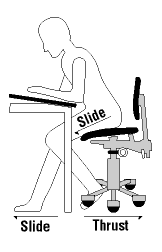
What are some advantages of a forward sloping chair?
Back to topThe use of a forward sloping chair may:
- Increase the number of possible positions
- Improve visual distance and angle to the task on a worktable
- Improve return blood flow from the lower legs, provided that the effort is more dynamic than static load on the muscles
What are some disadvantages of a forward sloping chair?
Back to topThe use of a forward sloping chair may:
- Place more weight on legs to control forward tilt of the upper body which can result in earlier onset of fatigue
- Cause the body to slide forward; however, if the seat pan of such a chair is curved from front to back or has sufficient friction, it would allow the user to sit without sliding. Nevertheless, the user does have to exert some muscular effort in their legs to remain seated. This effort may be beneficial (providing the slope is not greater than 15 degrees) if it improves the return blood flow from the lower legs
- Cause clothing to ride up the legs
- Force the individual to lean forward on the work surface, thereby applying pressure on wrists, arms, and elbows
What is a kneeling chair?
Back to topA kneeling chair has a fixed seat sloping forward and padded support for knees. It does not have a back rest. A kneeling chair places the user in a modified kneeling position.
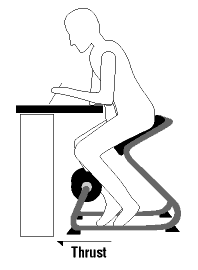
What are some advantages of a kneeling chair?
Back to topThe use of a kneeling chair may:
- Provide alignment for the spine or reduce the load on the lower back
- Make forward-reaching easier
- Improve visual distance and angle to the task on a worktable
What are some disadvantages of a kneeling chair?
Back to topThe use of a kneeling chair may:
- Cause knees and shins to bear weight
- Over-flex the knees
- Cause static load on muscles
- Limit the number of possible sitting positions
- Cause fatigue to develop earlier
- Force the individual to lean forward on the work surface, thereby applying pressure on wrists, arms, and elbows
- Reduce the range of reach
- Be awkward to get seated or stand again.
When would you use a saddle chair or a sit-stand seat?
Back to topSaddle chairs have a different style of seat, one similar to a saddle used by horseback riders. It often has a wider seat that encourages the legs to splay outwards.
What are some advantages of a saddle chair?
Back to topThe use of a saddle chair may:
- Encourage the user to have an upright, active posture
- Allow for a widened sit-stand (i.e., semi-standing) stance
- Be useful when the user needs to have a higher stance than a normal sitting position (e.g., a dentist needing to lean over a patient, or a cashier needing to be close to the eye level of customers)
- An alternative when accommodating individuals who can neither fully sit nor stand
What are some disadvantages of a saddle chair?
Back to topThe use of a saddle chair may:
- Place pressure on the genital area where the seat is raised
- Cause static load on the back and accelerate fatigue
What is a wearable or chairless chair?
Back to topA wearable chair replaces many of the physical structures of a traditional chair with components that are attached directly to the body. It allows sitting or semi-sitting positions to be adopted in environments or tasks where chairs are not ideal.
What are some advantages of a wearable chair?
Back to topThe use of a wearable chair may:
- Allow users to be more mobile while still being able to sit when needed(e.g., working at different locations in a large warehouse, rotating workstations)
- Allow adjustments to the sitting angle
What are some disadvantages of a wearable chair?
Back to topThe use of a wearable chair may:
- Cause pressure on the underside of the thighs if the supports are too narrow
- Cause pressure on any point of the body where straps are used to attach the device to the body (e.g., buttocks, thighs, ankles, etc.)
- Cause static load on the back and accelerate fatigue
- Add weight that must be carried by the user
- Restrict movement in certain situations
Are there some other things I should know about alternative seating?
Back to topSit/stand rests or chairs and sitting/kneeling support could be made available in certain situations.
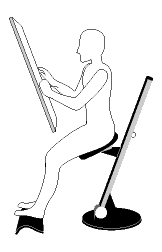
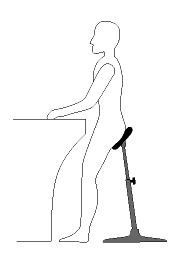
Rest Chair
It is desirable to have a chair for resting even when work can only be done standing. If space is limited, then a chair that can be folded up and stored out of the way can be used.
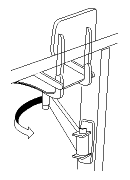
Sitting/Kneeling Support
Making hip support available where the work requires kneeling:
- Reduces tension in the thigh muscles, by widening the angle of the knees.
- Reduces compression on the knees, ankles and lumbar region (middle to lower back).
- Improves blood circulation.
.gif)
- Do not maintain kneeling/sitting position for extended periods.
- Avoid bending.
- Stand up and walk whenever possible.
.gif)
What are the advantages and disadvantages of using fitness or exercise balls as seating?
Back to topFitness (also known as exercise, therapy, or stability) balls are used by some people as an alternative chair. The ball must be of the right strength, size, and quality to support the person using it. If recommended by a health care professional, the program should include recommendations such as how long to use the ball per day, how many days, and other accommodations.
What are some advantages of a fitness ball chair?
Back to topThe use of a fitness ball chair may:
- Encourage dynamic posture
What are some disadvantages of a fitness ball chair?
Back to topThe use of a fitness ball chair may:
- Require high concentration and coordination to maintain posture
- Cause accelerated fatigue due to active, dynamic postures
- Cause arm, shoulder, and back fatigue due to lack of arm rests and back support
- Make tasks that involve reaching, swiveling, or moving more difficult
- Increase the risk of falling when compared to other types of chairs
- Fact sheet last revised: 2022-09-29

